service CHEVROLET BLAZER 1997 2.G Owners Manual
[x] Cancel search | Manufacturer: CHEVROLET, Model Year: 1997, Model line: BLAZER, Model: CHEVROLET BLAZER 1997 2.GPages: 402, PDF Size: 21.93 MB
Page 2 of 402
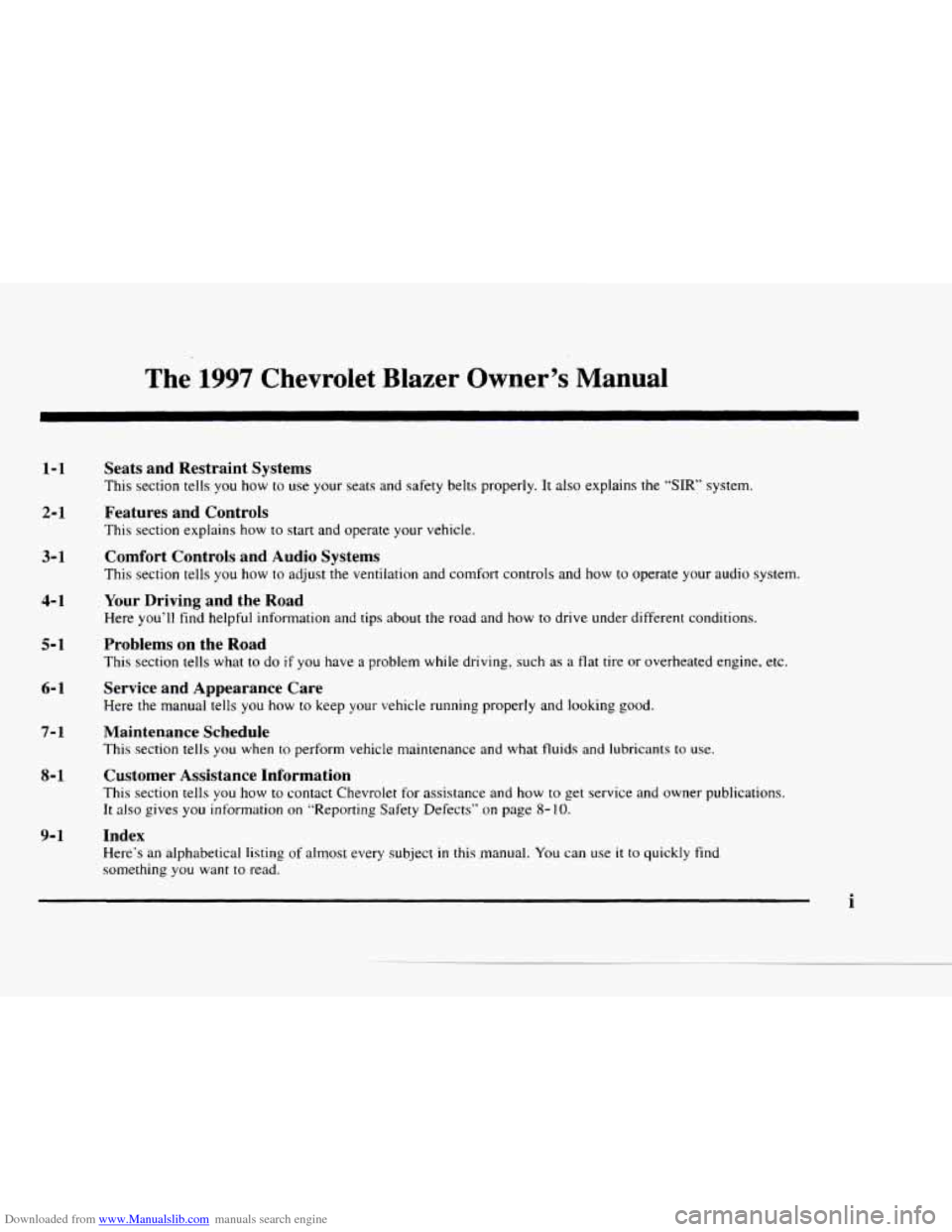
Downloaded from www.Manualslib.com manuals search engine The 1997 Chevrolet Blazer Owner’s Manual
1-1
2-1
3- 1
4- 1
5-1
6- 1
7- 1
8- 1
9- 1
Seats and Restraint Systems
This section tells you how to use your seats and safety belts\
properly. It also explains the “SIR” system.
Features and Controls
This section explains how to start and operate your vehicle.
Comfort Controls and Audio Systems
This section tells you how to adjust the ventilation and comfort controls and how to \
operate your audio system.
Your Driving and the Road
Here you’ll find helpful information and tips about the road\
and how to drive under different conditions.
Problems on the Road
This section tells what to do if you have a problem while driving, such as a flat tire or overheated engine, etc.
Service and Appearance Care
Here the manual tells you how to keep your vehicle running pr\
operly and looking good.
Maintenance Schedule
This section tells you when to perform vehicle maintenance and \
what fluids and lubricants to use.
Customer Assistance Information
This section tells you how to contact Chevrolet for assistance \
and how to get service and owner publications.
It also gives you information on ”Reporting Safety Defects” on pag\
e 8- 10.
Index
Here’s an alphabetical listing of almost every subject in this ,manual. You can use it to quickly find
something you want to read.
i
Page 3 of 402

Downloaded from www.Manualslib.com manuals search engine GENERAL MOTORS, GM, the GM Emblem.
CHEVROLET, the CHEVROLET Emblem and the
name BLAZER are registered trademarks
of General
Motors Corporation.
This manual includes the latest information at the time
it
was printed. We reserve the right to make changes in the
product after that time without further notice. For
vehicles first sold in Canada, substitute the name
“General Motors
of Canada Limited” for Chevrolet
Division whenever it appears
in this manual.
Please keep this manual in your vehicle,
so it will be
there if you ever need
it when you‘re on the road. If you
sell the vehicle, please leave this manual in it so the new
owner can use
it.
Litho in U.S.A.
C97 1 1 B First Edition
-) We support voluntary
WE SUPPORT VOLUNTARY TECHNICIAN
CERTIFICATION THROUGH
Natlonal Institute for
AUTOMOTIVE SERVICE EXCELLENCE
technician certification.
For Canadian Owners Who Prefer a
French Language Manual:
Aux propribtaires canadiens: Vous pouvez vous
procurer un exemplaire de ce guide en franpis chez
votre concessionaire ou au:
DGN Marketing Services Ltd.
1500 Bonhill Rd.
Mississauga, Ontario L5T IC7
“Copyright General Motors Corporation
1996
All Rights Reserved
ii
Page 31 of 402
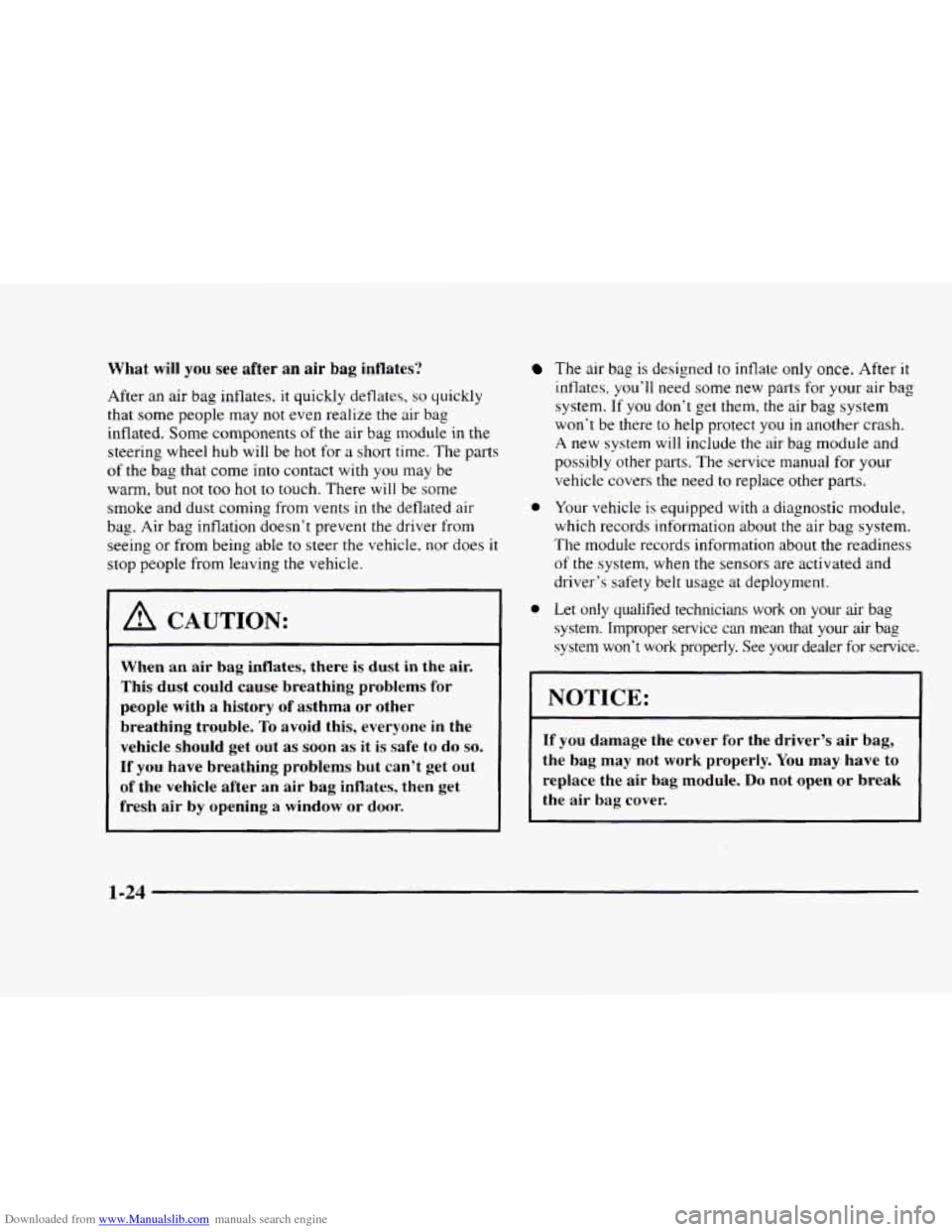
Downloaded from www.Manualslib.com manuals search engine What will you see after an air bag inflates?
After an air bag inflates, it quickly deflates, so quickly
that some people may not even realize the air bag
inflated. Some components of the air bag module
in the
steering wheel hub will be hot for a short time. The parts
of the bag that come into contact with you may be
warm, but not too
hot to touch. There will be some
smoke and dust coming from vents
in the deflated air
bag. Air bag inflation doesn’t prevent the driver from
seeing or from being able to steer
the vehicle. nor does it
stop people from leaving the vehicle.
A CAUTION:
When an air bag inflates, there is dust in the air.
This dust could cause breathing problems for
people with
a history of asthma or other
breathing trouble. To avoid this, everyone in the
vehicle should get out as soon as it
is safe to do so.
If you have breathing problems but can’t get out
of the vehicle after an air bag inflates, then get
fresh air
by opening a window or door.
0
0
The air bag is designed to inflate only once. After it
inflates, you’ll need some new parts for your air bag
system. If you don’t get them, the air bag system
won’t be there to help protect you in another crash.
A new system will include the air bag module and
possibly other parts. The service manual for your
vehicle covers the need
to replace other parts.
Your vehicle is equipped with
it diagnostic module,
which records information about the air bag system.
The module records information about the readiness
of the system. when the sensors are activated and
driver’s safety belt usage at deployment.
Let only qualified technicians work on your
air bag
system. Improper service can mean
that your air bag
system won’t work properly. See your dealer for service.
NOTICE:
If you damage the cover for the driver’s air bag,
the bag may not work properly. You may have to
replace the air bag module.
Do not open or break
the
air bag cover.
1-24
Page 32 of 402
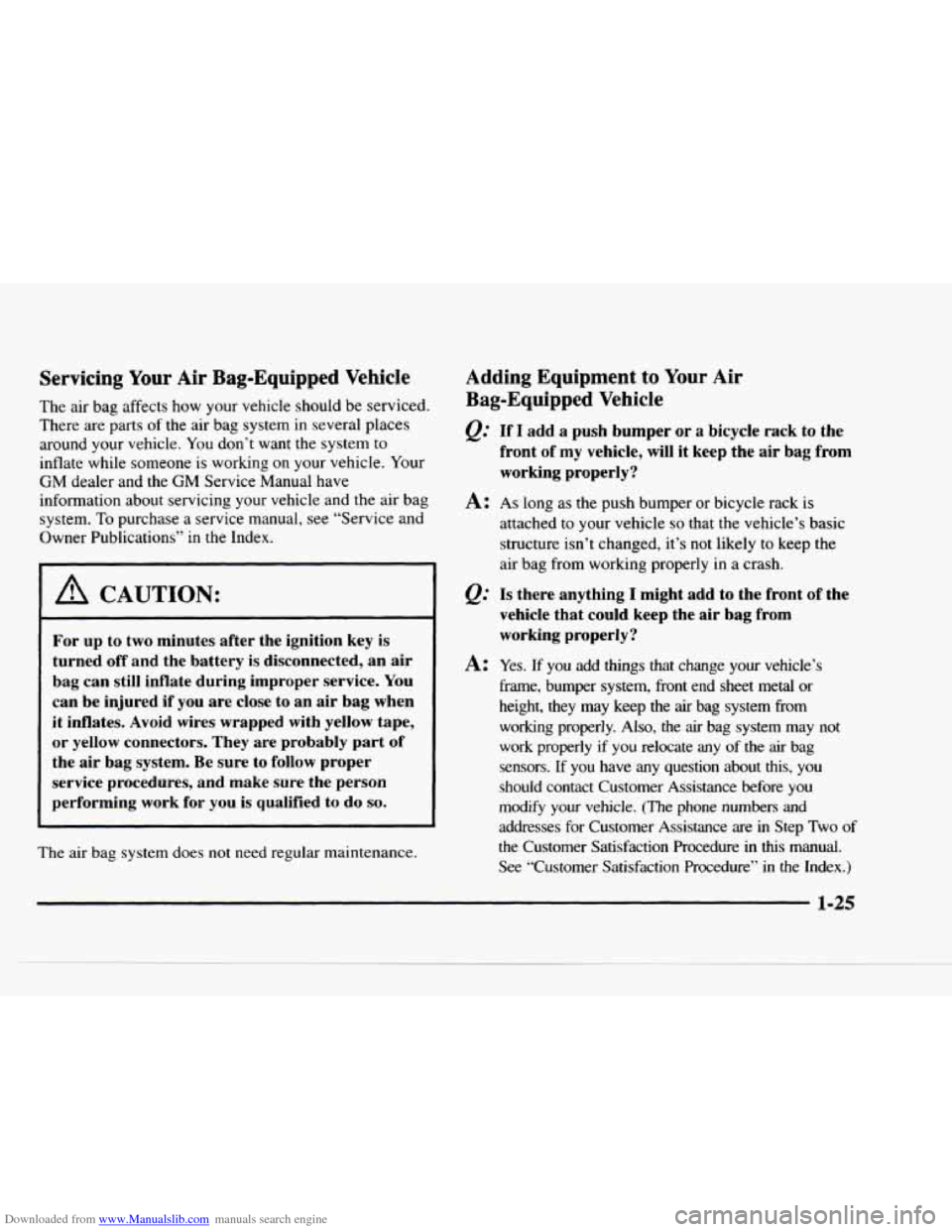
Downloaded from www.Manualslib.com manuals search engine Servicing Your Air Bag-Equipped Vehicle
The air bag affects how your vehicle should be serviced.
There are parts
of the air bag system in several places
around your vehicle. You don’t
want the system to
inflate while someone is working on your vehicle. Your
GM dealer and the GM Service Manual have
information about servicing your vehicle and the air bag
system. To purchase a service manual, see “Service and
Owner Publications” in the Index.
A CAUTION:
For up to two minutes after the ignition key is
turned off and the battery is disconnected, an air
bag can still inflate during improper service.
You
can be injured if you are close to an air bag when
it inflates. Avoid wires wrapped with yellow tape,
or yellow connectors. They are probably part
of
the air bag system. Be sure to follow proper
service procedures, and make sure the person
performing work for you
is qualified to do so.
~ ~ ~~~~ ~ ~
The air bag system does not need regular maintenance.
Adding Equipment to Your Air
Bag-Equipped Vehicle
Q: If I add a push bumper or a bicycle rack to the
front
of my vehicle, will it keep the air bag from
working properly?
A: As long as the push bumper or bicycle rack is
attached to your vehicle
so that the vehicle’s basic
structure isn’t changed, it’s not likely to keep the
air bag from working properly in a crash.
@’ Is there anything I might add to the front of the
vehicle that could keep the air
bap from
working properly?
A: Yes. If you add things that change your vehicle’s
frame, bumper system, front end sheet metal or
height, they may keep the
air bag system from
working properly. Also, the
air bag system may not
work properly
if you relocate any of the air bag
sensors.
If you have any question about this, you
should contact Customer Assistance before you
modify your vehicle. (The phone numbers
and
addresses for Customer Assistance are in Step Two of
the Customer Satisfaction Procedure in this manual.
See “Customer Satisfaction Procedure” in the Index.)
Page 63 of 402
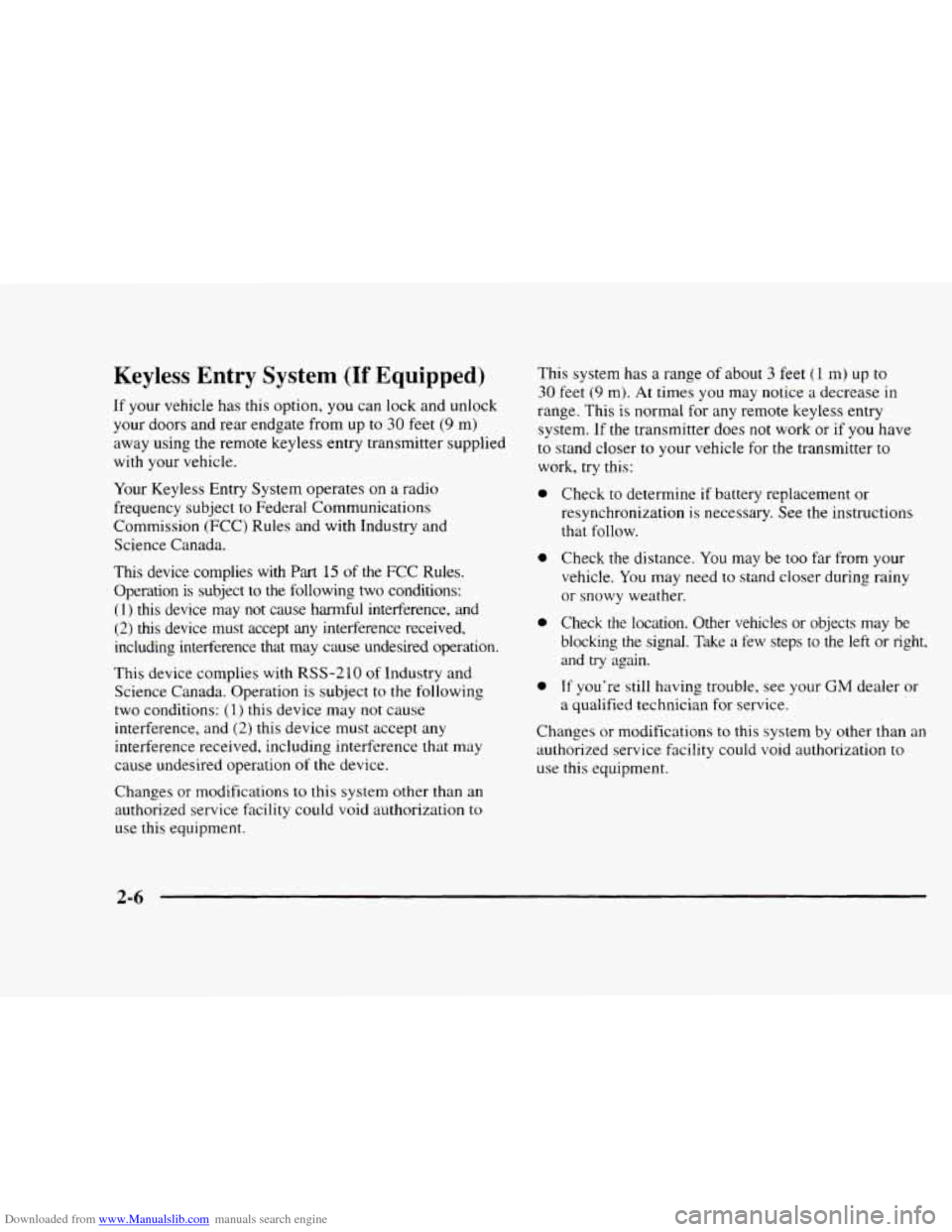
Downloaded from www.Manualslib.com manuals search engine Keyless Entry System (If Equipped)
If your vehicle has this option, you can lock and unlock
your doors and rear endgate from up
to 30 feet (9 m)
away using the remote keyless entry transmitter supplied
with your vehicle.
Your Keyless Entry System operates on
a radio
frequency subject to Federal Communications
Commission (FCC) Rules and with Industry and
Science Canada.
This device complies with
Part 15 of the FCC Rules.
Operation
is subject to the following two conditions:
(1 ) this device may not cause harmful interference, and
(2) this device must accept any interference received,
including interference that
may cause undesired operation.
This device complies with
RSS-210 of Industry and
Science Canada. Operation is subject
to the following
two conditions:
(1) this device may not cause
interference, and
(2) this device must accept any
interference received. including interference that may
cause undesired operation
of the device.
Changes or modifications to this system other than an
authorized service facility could void authorization
to
use this equipment. This
system has
a range of about 3 feet (1 m) up to
30 feet (9 m). At times you may notice a decrease in
range. This is normal for any remote keyless entry
system. If the transmitter does not work or if you have
to stand closer to your vehicle for the transmitter to
work, try this:
0
e
e
e
Check to determine if battery replacement or
resynchronization
is necessary. See the instructions
that follow.
Check the distance.
You may be too far from your
vehicle. You may
need to stand closer during rainy
or snowy weather.
Check the location. Other vehicles or objects may be
blocking the signal. Take
a few steps to the left or right,
and
try again.
If you're still having trouble. see your GM dealer or
a qualified technician for service.
Changes or modifications
to this system by other than an
authorized service facility could void authorization to
use this equipment.
2-6
Page 65 of 402
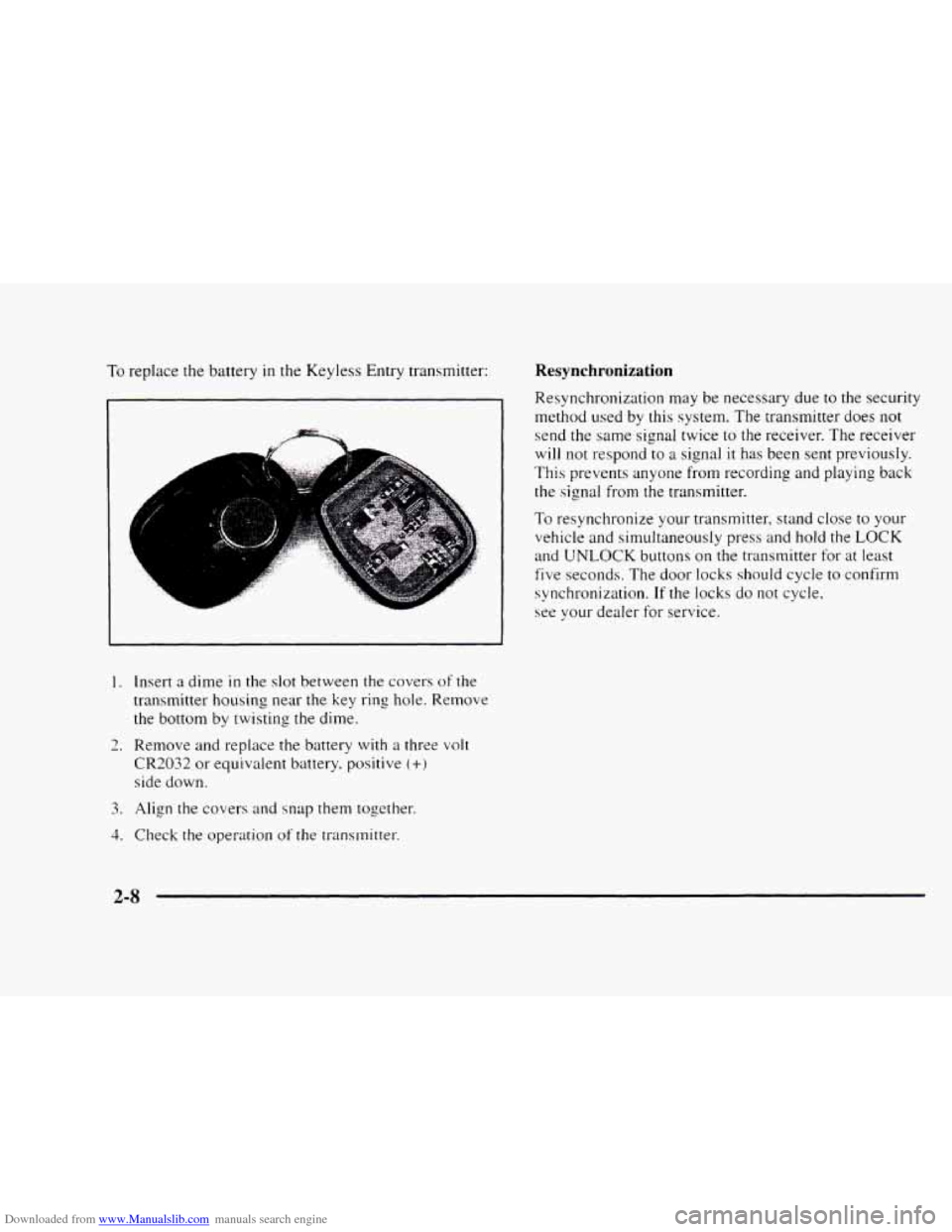
Downloaded from www.Manualslib.com manuals search engine To replace the battery in the Keyless Entry transmitter:
L
&.
I.
2.
3.
4.
Insert a dime in the slot between the covers of the
transmitter housing near the key ring hole. Remove
the bottom by twisting the dime.
Remove and replace the battery with
a three volt
CR2032 or equivalent battery, positive (+)
side down.
Align
the covers and snap them together.
Check the operation
of the transmitter.
Resynchronization
Resynchronization may be necessary due to the security
method used by this system. The transmitter does
not
send the same signal twice to the receiver. The receiver
will not respond to a signal it has been sent previously.
This prevents anyone from recording
and playing back
the signal from the transmitter.
To resynchronize your transmitter, stand close to your
vehicle and simultaneously press and hold the
LOCK
and UNLOCK buttons on the transmitter for at least
five seconds. The door locks should cycle to confirm
synchronization.
If the locks do not cycle,
see your dealer for service.
2-8
Page 71 of 402
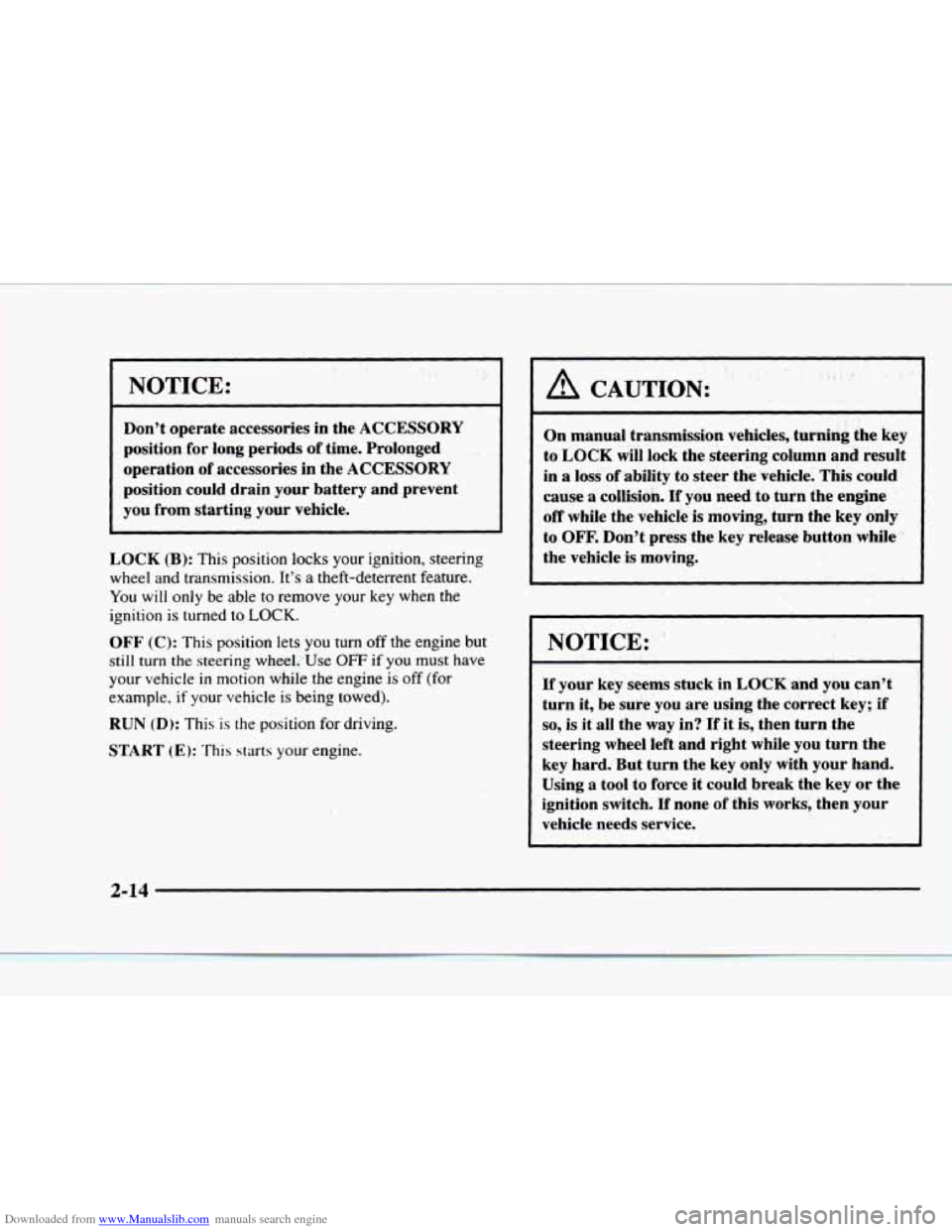
Downloaded from www.Manualslib.com manuals search engine NOTICE:
Don’t operate accessories in the ACCESSORY
position for long periods
of time. Prolonged
operation
of accessories in the ACCESSORY
position could drain your battery and prevent
you from starting your vehicle.
LOCK
(B): This position locks your ignition, steering
wheel and transmission. It’s
a theft-deterrent feature.
You will only be able to remove your key when the
ignition
is turned to LOCK.
OFF (C): This position lets you turn off the engine but
still turn the steering wheel. Use OFF if you must have
your vehicle
in motion while the engine is off (for
example,
if your vehicle is being towed).
RUN (D): This is the position for driving.
START (E): This starts your engine.
A CAUTION:
On manual transmission vehicles, turning the key
to LOCK will lock the steering column and result
in
a loss of ability to steer the vehicle. This could
cause a collision.
If you need to turn the engine
off while the vehicle is moving, turn the key only
to
OFF. Don’t press the key release button while
the vehicle
is moving.
_. .
NOTICE^^' Y!’> .‘sa !-
If your key seems stuck in LOCK and you can’t
turn it, be sure you are using the correct key; if
so, is it all the way in? If it is, then turn the
steering wheel left and right while you turn the
key hard. But turn the key only with your hand.
Using a tool to force
it could break the key or the
ignition switch.
If none of this works, then your
vehicle needs service.
2-14
Page 84 of 402
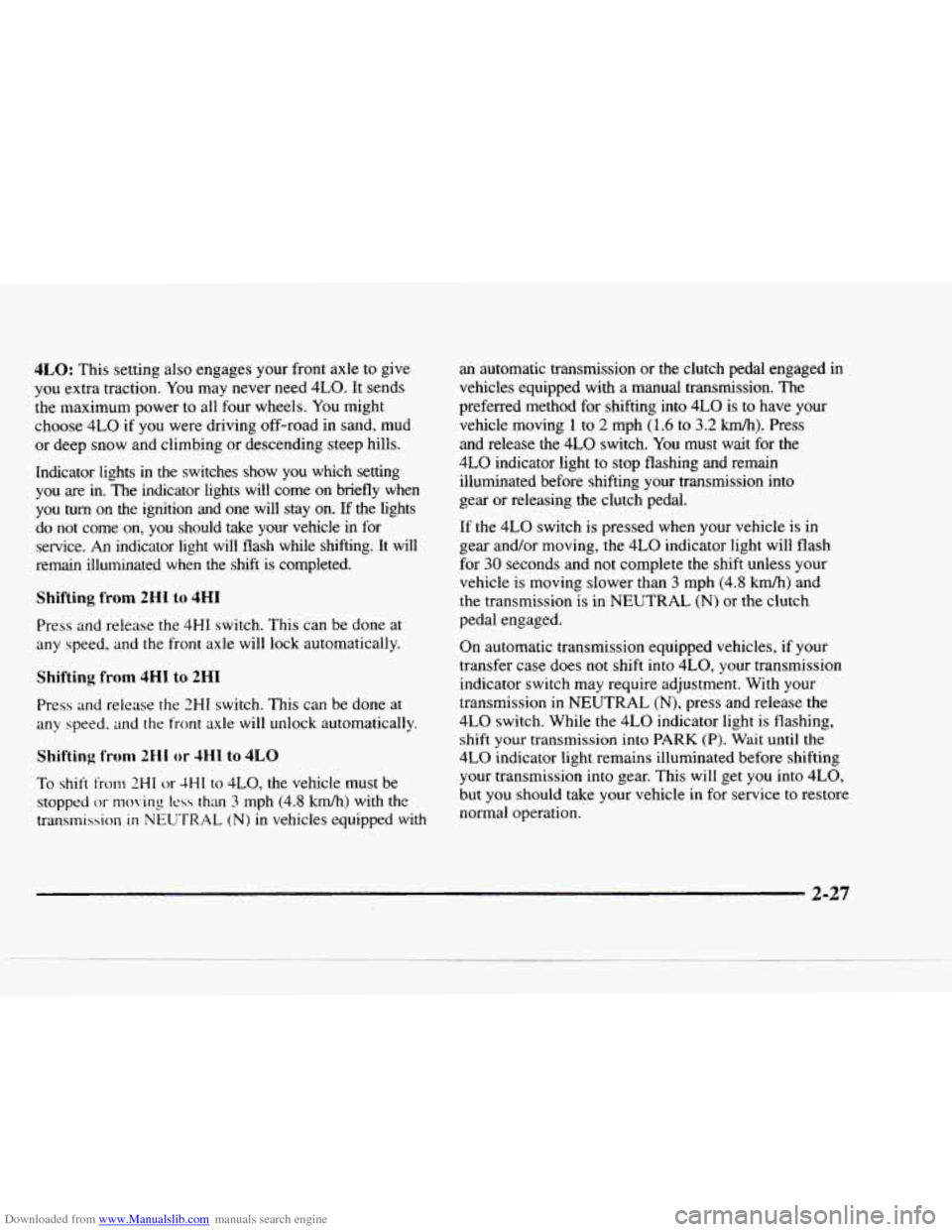
Downloaded from www.Manualslib.com manuals search engine 4LO: This setting also engages your front axle to give
you extra traction. You may never need
4LO. It sends
the maximum power
to all four wheels. You might
choose
4LO if you were driving off-road in sand, mud
or deep snow and climbing or descending steep hills.
Indicator lights
in the switches show you which setting
you are
in. The indicator lights will come on briefly when
you
turn on the ignition and one will stay on. If the lights
do not come on, you should take your vehicle in for
service. An indicator light
will flash while shifting. It will
remain illuminated when the shift is completed.
Shifting from 2HI to 4HI
Press and release the 4HI switch. This can be done at
any speed, and the front axle will lock automatically.
Shifting from 4HI to 2HI
Press and release the 2HI switch. This can be done at
any speed.
and the front axle will unlock automatically.
Shifting from 2HI or JHI to 4LO
To shift tiom ZHI or -!HI to 4L0, the vehicle must be
stopped or mo\fing less than 3 mph (4.8 kmk) with the
transmission
in NEUTRAL (N) in vehicles equipped with
an automatic transmission or the clutch pedal engaged in
vehicles equipped with a manual transmission.
The
preferred method for shifting into 4LO is to have your
vehicle moving
1 to 2 mph (1.6 to 3.2 km/h). Press
and release the
4LO switch. You must wait for the
4LO indicator light to stop flashing and remain
illuminated before shifting your transmission into
gear or releasing the clutch pedal.
If
the 4LO switch is pressed when your vehicle is in
gear and/or moving, the
4LO indicator light will flash
for
30 seconds and not complete the shift unless your
vehicle is moving slower than 3 mph (4.8
kmk) and
the transmission is in
NEUTRAL (N) or the clutch
pedal engaged.
On automatic transmission equipped vehicles,
if your
transfer case does not shift into 4L0, your transmission
indicator switch may require adjustment. With your
transmission in
NEUTRAL (N), press and release the
4LO switch. While the
4LO indicator light is flashing,
shift
your transmission into PARK (P). Wait until the
4LO indicator light remains illuminated before shifting
your transmission into gear. This will get you into 4L0,
but you should take your vehicle in for service to restore
normal operation.
2-27
Page 85 of 402

Downloaded from www.Manualslib.com manuals search engine Shifting from 4LO to 4HI or 2HI
To shift from 4LO to 4HI or 2H1, your vehicle must be
stopped or moving less than 3 mph (4.8 kmh) with the
transmission in NEUTRAL (N) or the clutch pedal
engaged. The preferred method for shifting out
of
4LO is to have your vehicle moving 1 to 2 mph (1.6 to
3.2 km/h). Press and release the 4HI switch. You must
wait for the
4HI indicator light to stop flashing and
remain illuminated before shifting your transmission
into gear or releasing
the clutch pedal.
If the 4HI switch is pressed when your vehicle is in gear
and/or moving, the
4HI indicator light will flash for
30 seconds but not complete the shift unless the
vehicle is moving slower than
3 mph (4.8 km/h) and
the transmission
is in NEUTRAL (N) or the clutch
pedal engaged.
On automatic transmission equipped vehicles, if your
transfer case does not shift into
4H1, your transmission
indicator switch may require adjustment. With your
transmission in NEUTRAL
(N), press and release the
4HI switch. While the 4HI indicator light is flashing,
shift your transmission into PARK
(P). Wait until the
4HI indicator light remains illuminated before shifting
your transmission into gear. This will get
you into 4HI.
but you should
take your vehicle in for service to restore
normal operation.
2-2s
Page 126 of 402
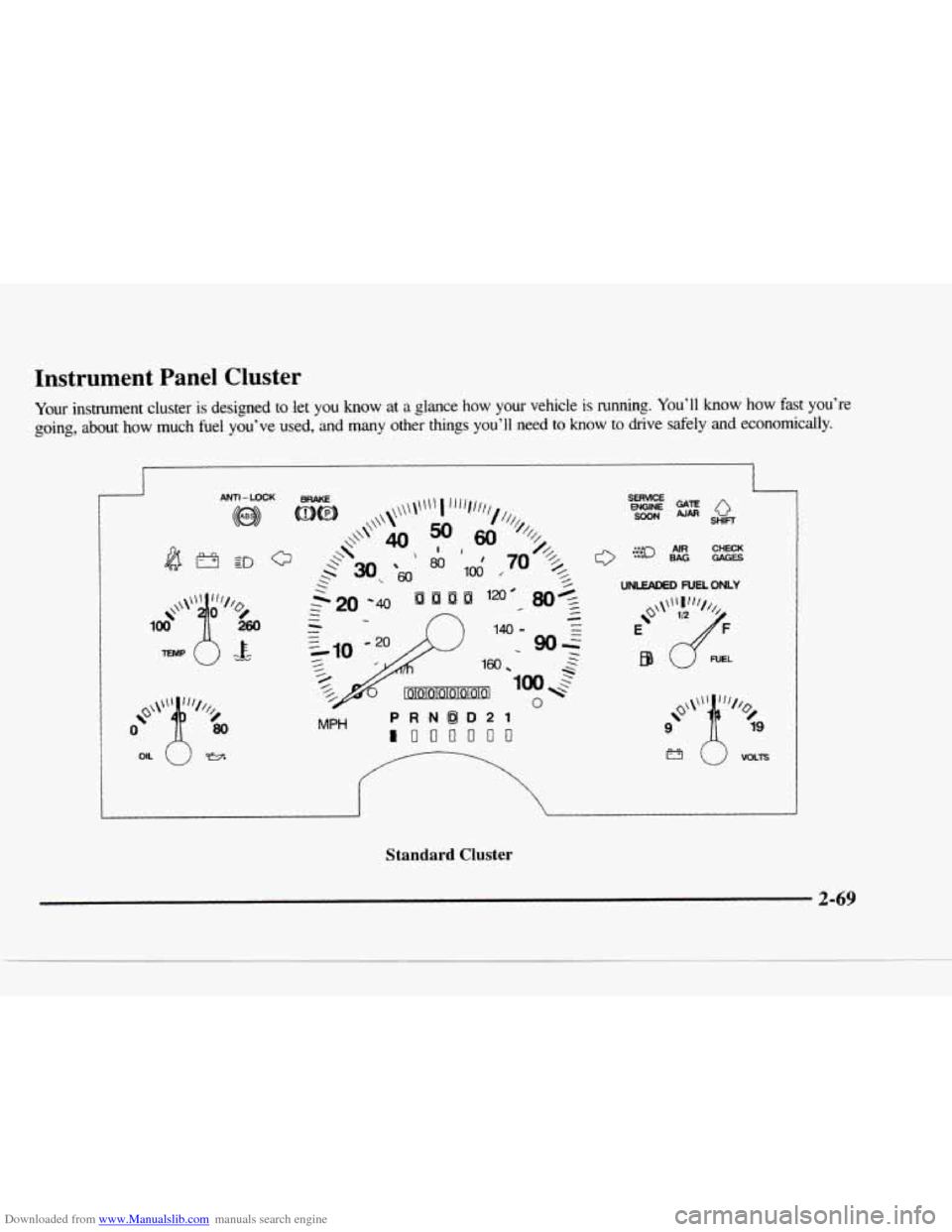
Downloaded from www.Manualslib.com manuals search engine Instrument Panel Cluster
Your instrument cluster is designed to let you know at a glance how your vehicle is running. You'll know how fast you're
going, about how much fuel you've used,
and many other things you'll need to know to drive safely and economically.
MPH PRN@D21
I000000
1 SERVICE GATE ENGINE
AJAR SHIFT 0
UNLEAMD FUEL ONLY
Standard Cluster
2-69